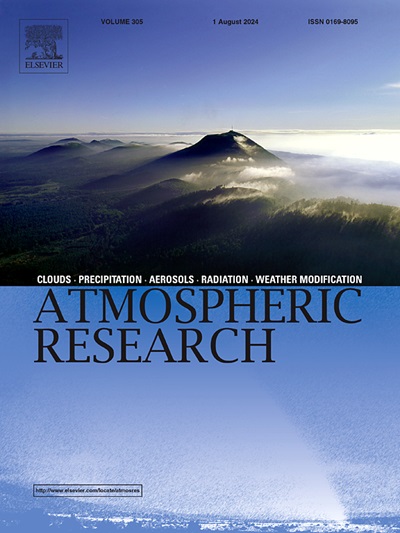Intraseasonal relationship of winter temperatures in North America and warm sea surface temperatures in the Northeast Pacific
IF 4.5
2区 地球科学
Q1 METEOROLOGY & ATMOSPHERIC SCIENCES
引用次数: 0
Abstract
Winter temperatures in the North America (NA) exhibit evident intraseasonal variation, which has become more pronounced under global climate change. In particular, the wintertime relationship between NA temperatures and long-lasting positive sea surface temperature anomalies (SSTAs) in the Northeast Pacific (NEP), known as warm blobs, has been hotly debated in recent years. However, their relationship on intraseasonal timescales remains unclear. Using reanalysis data and an Atmospheric General Circulation Model, this study reveals that the intraseasonal variation of atmospheric circulation is the primary factor to induce intraseasonal temperature anomalies in NA after classifying warm SSTA events based on their different evolutions. Moreover, the atmospheric circulation anomalies over the mid-to-high-latitude regions are in part contributed by the feedback of NEP warm SSTAs to the atmosphere. Specifically, for early-winter warm SSTA events (peaking in November), there are two intraseasonal reversals in geopotential height anomalies over the NEP and NA, corresponding to a “cold-warm-cold” temperature change in NA. However, for mid-winter warm SSTA events (peaking in January), the atmospheric circulation pattern is relatively stable, mainly characterized by a “west high-east low” dipole, associated with persistent cold anomalies in NA. Then, the role of warm SSTAs over the NEP in the intraseasonal temperature variation is generally verified by the numerical simulations. Hence, although the NEP warm SSTAs may not be the dominant driver of the intraseasonal variations of winter NA temperatures, we emphasize the implication of their evolutionary differences in reflecting the NA temperature variations, which contributes to better predictability.
北美冬季气温与东北太平洋暖海面温度的季节内关系
北美洲(NA)的冬季气温表现出明显的季节内变化,这种变化在全球气候变化的影响下变得更加明显。特别是,近年来,北美洲冬季气温与东北太平洋(NEP)海面温度异常(SSTA)(即暖球)之间的关系一直备受争议。然而,它们在季节内时间尺度上的关系仍不清楚。本研究利用再分析数据和大气环流模式,根据暖SSTA事件的不同演变过程对其进行分类后发现,大气环流的季内变化是诱发北太平洋季内温度异常的主要因素。此外,中高纬度地区的大气环流异常在一定程度上是由NEP暖SSTA对大气的反馈作用造成的。具体来说,对于初冬暖 SSTA 事件(在 11 月达到峰值),NEP 和 NA 上的位势高度异常会出现两次季节内逆转,与 NA 的 "冷-暖-冷 "温度变化相对应。然而,在暖 SSTA 事件的冬季中期(1 月份达到峰值),大气环流模式相对稳定,主要表现为 "西高东低 "偶极子,与北大西洋的持续冷异常有关。因此,数值模拟基本验证了北太平洋暖 SSTA 在季内温度变化中的作用。因此,虽然北太平洋暖性高温热气流不一定是北大西洋冬季气温季内变化的主要驱动力,但我们强调它们的演变差异在反映北大西洋气温变化方面的意义,这有助于提高北大西洋气温的可预测性。
本文章由计算机程序翻译,如有差异,请以英文原文为准。
求助全文
约1分钟内获得全文
求助全文
来源期刊

Atmospheric Research
地学-气象与大气科学
CiteScore
9.40
自引率
10.90%
发文量
460
审稿时长
47 days
期刊介绍:
The journal publishes scientific papers (research papers, review articles, letters and notes) dealing with the part of the atmosphere where meteorological events occur. Attention is given to all processes extending from the earth surface to the tropopause, but special emphasis continues to be devoted to the physics of clouds, mesoscale meteorology and air pollution, i.e. atmospheric aerosols; microphysical processes; cloud dynamics and thermodynamics; numerical simulation, climatology, climate change and weather modification.
 求助内容:
求助内容: 应助结果提醒方式:
应助结果提醒方式:


